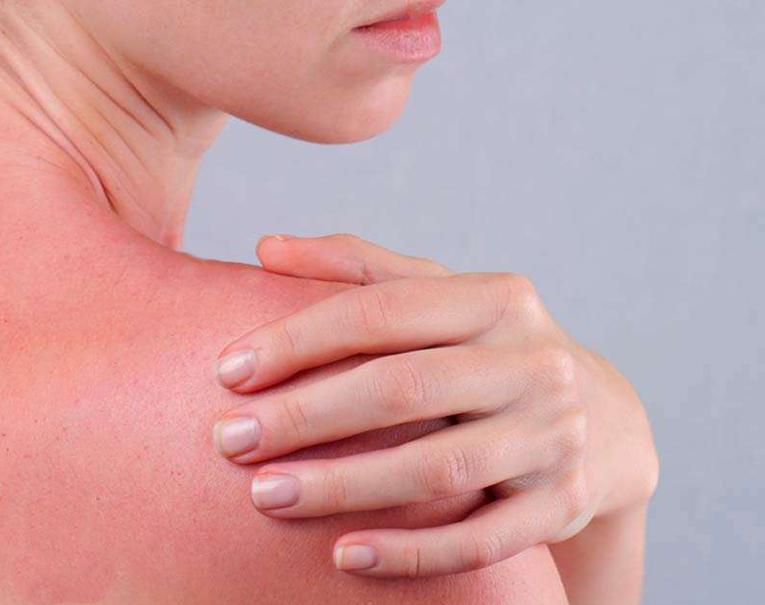Innovative Non-Toxic Skin Healing Solutions

As the summer winds down, crowds of people rush to the outdoors to soak up the last rays of the season. While sunlight is an excellent source of vitamin D, prolonged exposure to ultraviolet (UV) rays could wreak havoc on your skin and increase your risk of skin cancer.
UV rays lead to increased free radical damage and oxidative stress, destroying epidermal cells and causing inflammation. Sadly, if you don’t take proper precaution applying sunscreen or wearing protective clothing, you could be left with a nasty first degree sunburn. Read more to learn about the symptoms, prevention, and natural treatments you have when it comes to healing a sunburn.
The Science Behind a Sunburn
Did you know your skin is thicker in the summer than in the winter? This is one of your body’s natural defense mechanisms for protecting against oxidative stress of UV rays. Another is the pigmentation of your skin, which explains why people with darker skin do not sunburn as easily. Although, all are still susceptible to its carcinogenic and premature aging harms.
Your pigmentation, the UV index, climate conditions, and length of sun exposure combine to determine when you’ll begin to sunburn. For some, this will be in 15 minutes and for others much longer. This first indication of sunburn when your skin turns a light pink is known as your minimal erythema dose (MED).
After this point has been reached, your skin has already soaked up enough UV rays to cause visible damage. Stay in the sun longer and the effects compound. This trauma is not only occurring on your epidermis but on deeper cellular levels as well, increasing free radical exposure and inflammation.
What to Do Immediately After
When your skin is red, burning, swollen, and achy, most people want to focus on sunburn relief. However, it’s vital to focus your efforts on healing your damaged skin. One of the first steps you should take when sunburned is to protect your skin from the sun by limiting any further sun exposure. Take a cool bath or shower. Cool water on your skin helps to soothe the skin and remove salt, sand, or other irritants. Avoid bathing with harsh soaps or chemicals that may irritate the skin, or frequently touching your skin.
Also, be sure to drink plenty of water. Drink extra water to stay hydrated, and keep your skin moisturized to help soothe the pain.
Expect your skin to begin peeling in a few days. Peeling skin is the body’s way of shedding the damaged epidermis. If you are severely sunburned and have injured your dermis or second layer of skin, blisters might even form. It’s important to resist the urge to pick at your skin and allow enough time for it to heal.
Natural Treatments for Sunburn
Increasingly, studies are showing the effectiveness of natural methods for treating sunburn and other skin trauma. Plant botanicals like calendula and aloe vera with its 75 active constituents, packed with antioxidants and glyconutrients, can help ease the stinging sensation on your skin. These natural substances also provide a barrier to keep as much moisture as possible for healing to take place. Soothing, cooling and hydrating sunburned skin is essential for repair.
One of the most powerful natural substances proven to accelerate healing and reduce inflammation and oxidative stress is astaxanthin. This potent antioxidant naturally occurs when marine species like shrimp, fish, or red algae H. Pluvialis are exposed to UV light. The highly-pigmented extract helps shield the body for longer from the damaging effects of prolonged sun exposure.
This amazing ingredient was first used by marine biologists and later as a food supplement once its strong antioxidant properties were discovered. Japanese scientists found that mice ingesting astaxanthin could be exposed to UV radiation for longer periods of time without getting sunburned. Astaxanthin is one of the main reasons why Seaside Medical Technologies’ Post-Traumatic Response Gel with MatrX B™, is an excellent choice to repair and soothe sun damaged skin.
By following this guidance, your skin will heal faster and the pain will subside. Still, it's important to realize that once you're sunburned, your skin has already suffered a trauma. Repeat sun exposure will only worsen the damage. While these natural healing solutions are packed with amazing ingredients that aid in repair, I recommend that you protect yourself from prolonged sun exposure in the future. Remember, protect the skin.
Comments will be approved before showing up.